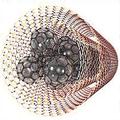 美國國家研究委員會(National Research Council)專家小組於10日表示,「美國政府極度缺乏適當的計畫,來研究奈米物質對健康及環境造成的潛在風險。」 該報告嚴厲呼籲應立刻採取行動、規畫一套有效率的全國計劃,以鑑定和管理奈米科技的潛在風險;此外也提出警告,表示如果不這麼做,便可能波及這塊領域在未來的迅速發展。
美國國家研究委員會(National Research Council)專家小組於10日表示,「美國政府極度缺乏適當的計畫,來研究奈米物質對健康及環境造成的潛在風險。」 該報告嚴厲呼籲應立刻採取行動、規畫一套有效率的全國計劃,以鑑定和管理奈米科技的潛在風險;此外也提出警告,表示如果不這麼做,便可能波及這塊領域在未來的迅速發展。
奈米科技是以接近原子或分子尺度對物質進行改造,以開發新材料、新產品或改進原有材料及產品的一門科學。
目前已有數百種含有奈米物質的消費者商品在市面上流通,舉凡化妝品、防曬用品、衣服及牙膏等都有。然而奈米科技產品的未來光景絕不僅於此,科學家聲稱說未來奈米科技將在醫療保健、能源及製造業掀起革命。
基改奈米物質的微小尺寸比一根頭髮寬度還要小幾千倍,在未來的確有相當有發展空間,但科學家現今仍在努力解決風險性問題;而就目前已知的問題而言,其中有些部分已引起專家長期以來相當關切。
科學家發現奈米微粒可通過腦血管障壁(Blood-brain barrier),另外也證實奈米物質可透過細胞或亞細胞對生物系統產生作用。
研究員在2008年初表示,某些特定產業用來創造強力物質及先進電子所使用的碳奈米管(Carbon nanotubes),所衍生的健康風險可能會和石綿有點雷同。確保這些物質在使用之前先行研究並評估其風險,應是美國的國家奈米科技啟動計劃(National Nanotechnology Initiative)中相當重要的一環。 然而國家奈米科技啟動計劃小組卻幾乎沒有發現相對應的風險研究方針的證據。
 國家研究委員主席、同時也是環保學家並任職於西雅圖華盛頓大學的職業健康學教授伊頓(David Eaton)表示,「現行計畫缺乏整體性的研究策略,來獲取大眾接受程度,並將奈米科技的承諾兌現。」
國家研究委員主席、同時也是環保學家並任職於西雅圖華盛頓大學的職業健康學教授伊頓(David Eaton)表示,「現行計畫缺乏整體性的研究策略,來獲取大眾接受程度,並將奈米科技的承諾兌現。」
委員會表示,國家奈米科技啟動計劃缺乏遠見,除了沒有明確目標,也未建立一套研究方向的優先順序,釐清奈米科技對工作者、大眾或是環境可能產生的風險。
此外,國家奈米科技啟動計劃也未針對在未來5年或10年,奈米科技對環境、健康和安全應用等發展狀況,提供清楚的願景。而委員會認為,這些問題的主要原因在於國家奈米科技啟動計劃的架構過於鬆散。
The U.S. government's plan to research the potential health and environmental risks from engineered nanomaterials is woefully inadequate, an expert panel of the National Research Council said Wednesday. The scathing report urges immediate action to craft an effective national plan for identifying and managing the potential risks of nanotechnology, warning that failure to do so could undermine the future of the rapidly emerging field
Nanotechnology is the science of creating or modifying materials at the atomic and molecular level to develop new or enhanced materials and products.
Hundreds of consumer products that contain nanomaterials are already on the market, including cosmetics, sunscreen, clothing and toothpaste. But the future of nanotechnology looks far beyond such products, as scientists contend it will allow them to revolutionize health care, energy and manufacturing.
The tiny size of engineered nanomaterials - thousands of times smaller than the width of a human hair - could allow such advancements, but scientists are still grappling with the risks.
Some of what is understood has experts very concerned.
Scientists have discovered that nanoparticles can bypass the blood brain barrier and found evidence that nanomaterials can affect biological systems at cellular and subcellular levels.
Earlier this year researchers reported that carbon nanotubes - something industry is keen to use for super strong materials and advanced electronics - may pose similar health risks to those posed by asbestos.
Ensuring such materials are not used before the risks have been researched and assessed is supposed to be a key part of the U.S. government's National Nanotechnology Initiative.
But the panel's review of the National Nanotechnology Initiative found little evidence that such it has developed a coherent risk research strategy.
The current plan "does not present an over-arching research strategy needed to gain public acceptance and realize the promise of nanotechnology," said committee chair David Eaton, an environmental and occupational health science professor at the University of Washington in Seattle.
The committee said the NNI's plan lacks vision, does not contain a clear set of goals and does not outline funding priorities for research needed to understand the possible risks of nanotechnology to workers, the public or the environment.
Furthermore, the NNI plan "does nor provide a clear vision as to where our understanding of the environmental, health and safety implications of nanotechnology should be in five or 10 years," according to the report.
The panel noted that a key problem is the loose structure of the National Nanotechnology Initiative.

